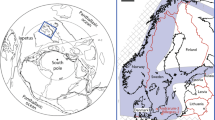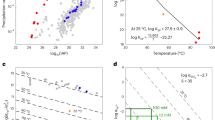Abstract
The timing of the origin of photosynthesis on the early Earth is greatly debated. It is generally agreed, on the basis of the presence of biological molecules found in shales from the Hamersley Basin, Australia, that oxygenic photosynthesis had evolved 2.7 billion years (Gyr) ago. However, whether photosynthesis occurred before this time remains controversial. Here we report primary haematite crystals and associated minerals within the marine sedimentary rocks preserved in a jasper formation of the Pilbara Craton, Australia, which we interpret as evidence for the formation of these rocks in an oxygenated water body 3.46 Gyr ago. We suggest that these haematite crystals formed at temperatures greater than 60 ∘C from locally discharged hydrothermal fluids rich in ferrous iron. The crystals precipitated when the fluids rapidly mixed with overlying oxygenated sea water, at depths greater than 200 m. As our findings imply the existence of noticeable quantities of molecular oxygen, we propose that organisms capable of oxygenic photosynthesis evolved more than 700 million years earlier than previously recognized, resulting in the oxygenation of at least some intermediate and deep ocean regions.
This is a preview of subscription content, access via your institution
Access options
Subscribe to this journal
Receive 12 print issues and online access
$259.00 per year
only $21.58 per issue
Buy this article
- Purchase on Springer Link
- Instant access to full article PDF
Prices may be subject to local taxes which are calculated during checkout






Similar content being viewed by others
References
Schopf, W. J. Microfossils of the Early Archean Apex chert: New evidence of the antiquity of life. Science 260, 640–646 (1993).
Brasier, M. D. et al. Questioning the evidence for Earth’s oldest fossils. Nature 416, 76–81 (2002).
Schopf, J. W., Kudryavtsev, A. B., Agresti, D. V., Wdowiak, T. J. & Czaja, A. D. Laser-Raman imagery of Earth’s earliest fossils. Nature 416, 73–76 (2002).
Ohmoto, H. et al. Biosignatures in ancient rocks: A summary of discussions at field workshop on biosignatures in ancient rocks. Astrobiology 8, 883–907 (2008).
Grotzinger, J. P. & Rothman, D. H. An abiotic model for stromatolite morphogenesis. Nature 383, 423–425 (1996).
Allwood, A. C., Walter, M. R., Kamber, B. S., Marchall, C. P. & Burch, I. W. Stromatolite reef from the Early Archaean era of Australia. Nature 441, 714–718 (2006).
Brocks, J. J., Logan, G. A., Buick, R. & Summons, R. E. Archean molecular fossils and the early rise of eukaryotes. Science 285, 1033–1036 (1999).
Konhauser, K. O. et al. Decoupling photochemical Fe(II) oxidation from shallow-water BIF deposition. Earth Planet. Sci. Lett. 258, 87–100 (2007).
Garcia-Pitchel, F. & Castenholz, R. W. Microbial Mats 77–84 (NATO ASI Series, Springer, 1994).
Head, J. W. III & Wilson, L. Deep submarine pyroclastic eruptions: Theory and predicted landforms and deposits. J. Volcanol. Geotherm. Res. 121, 155–193 (2003).
Bevacqua, D. C., Watanabe, Y. & Ohmoto, H. Origin of hematite in the 3.46 Gyr Towers formation. Astrobiology 6, 230 (2006).
Orberger, B. et al. Processes on the Early Earth Vol. 405, 133–156 (Geol. Soc. Am. Spec. Paper, Geological Society of America, 2006).
Kato, Y. & Nakamura, K. Origin and global tectonic significance of Early Archean cherts from the Marble Bar greenstone belt, Pilbara Craton, Western Australia. Precambrian Res. 125, 191–243 (2003).
van den Boom, S. H. J. M., van Bergen, M. J., Nijman, W. & Vroon, P. Z. Dual role of seawater and hydrothermal fluids in Early Archean chert formation: Evidence from silicon isotopes. Geology 35, 939–942 (2007).
Ohmoto, H. et al. in Evolution of Early Earth’s Atmosphere, Hydrosphere, and Biosphere—Constraints from Ore Deposits. Vol. 198 (eds Kesler, S. E. & Ohmoto, H.) 291–331 (Geol. Soc. Am. Memoir, Geological Society of America, 2006).
Trendall, A. F. & Blockley, J. G. The Iron Formations of the Precambrian Hamersley Group Western Australia Vol. 119 (Geol. Surv. W. Aus. Bull., 1970).
Ahn, J. H. & Buseck, P. R. Hematite nanospheres of possible colloidal origin from a Precambrian banded iron formation. Science 250, 111–113 (1990).
Trolard, F. & Tardy, Y. The stabilities of gibbsite, boehmite, aluminous goethites and aluminous hematites in bauxites, ferricretes and laterites as a function of water activity, temperature and particle size. Geochim. Cosmochim. Acta 51, 945–957 (1987).
Cornell, R. M. & Schwertmann, U. The Iron Oxides 2nd edn (Wiley–VCH, 2003).
Postma, D. Pyrite and siderite oxidation in swamp sediments. Eur. J. Soil Sci. 34, 163–182 (1983).
Stumm, W. & Morgan, J. J. Aquatic Chemistry—Chemical Equilibria and Rates in Natural Waters 3rd edn (Wiley, 1996).
Ohmoto, H., Watanabe, Y. & Kumazawa, K. Evidence from massive siderite beds for a CO2-rich atmosphere before ∼1.8 billion years ago. Nature 429, 395–399 (2004).
Ohmoto, H. Non-redox transformations of magnetite-hematite in hydrothermal systems. Econ. Geol. 98, 157–161 (2003).
Otake, T., Wesolowski, D. J., Anovitz, L. A., Allard, L. F. & Ohmoto, H. Experimental evidence for non-redox transformations between magnetite and hematite under H2-rich hydrothermal conditions. Earth Planet. Sci. Lett. 257, 60–70 (2007).
Drever, J. I. The Geochemistry of Natural Waters: Surface and Groundwater Environments 2nd edn (Prentice Hall, 1988).
Kato, Y., Yamaguchi, K. E. & Ohmoto, H. in Evolution of the Atmosphere, Hydrosphere, and Biosphere on Early Earth: Constraints from Ore Deposits Vol. 198 (eds Kesler, S. E. & Ohmoto, H.) 269–289 (Geol. Soc. Am. Memoir, Geological Society of America, 2006).
Rosing, M. T. & Frei, R. U-rich Archaean sea-floor sediments from Greenland—indications of >3,700 Myr oxygenic photosynthesis. Earth Planet. Sci. Lett. 217, 237–244 (2004).
Kato, Y. et al. Hematite formation by oxygenated groundwater more than 2.76 billion years ago. Earth Planet. Sci. Lett. 278, 40–49 (2009).
Acknowledgements
This study was carried out under The Archaean Biosphere Drilling Project (ABDP; see Supplementary Information), which was funded largely by the NASA Astrobiology Institute to H.O., the Geological Survey of Western Australia to A.H.H., the University of Western Australia to M. Barley and the Japanese Ministry of Science, Education, Sports and Culture to M. Nedachi. A.H.H. publishes with permission of the Executive Director of the Geological Survey of Western Australia. We are grateful to B. Runnegar, R. Grymes and A. Marshall for their support of the ABDP; Y. Suganuma and D. Walizer for laboratory assistance; M. Nedachi, M. Barley, E. Altinok, K. E. Yamaguchi, Y. Kato and K. Nakamura for discussions; and P. Heaney, C. de Ronde, A. W. Rose and H. L. Barnes for valuable comments on an earlier manuscript.
Author information
Authors and Affiliations
Contributions
Project planning was carried out by H.O., A.H.H. and M.H., sample analyses by M.H., D.C.B., Y.W., T.O. and S.U. and data analysis and writing mostly by H.O., M.H. and A.H.H. with input from D.C.B, Y.W., T.O. and S.U.
Corresponding author
Supplementary information
Supplementary Information
Supplementary Information (PDF 907 kb)
Rights and permissions
About this article
Cite this article
Hoashi, M., Bevacqua, D., Otake, T. et al. Primary haematite formation in an oxygenated sea 3.46 billion years ago. Nature Geosci 2, 301–306 (2009). https://doi.org/10.1038/ngeo465
Received:
Accepted:
Published:
Issue Date:
DOI: https://doi.org/10.1038/ngeo465
This article is cited by
-
Redrawing the early sulfur cycle
Nature Geoscience (2020)
-
Geochemical constraints on the genesis of the Ekou banded iron formation, Shanxi Province, North China
International Journal of Earth Sciences (2020)



